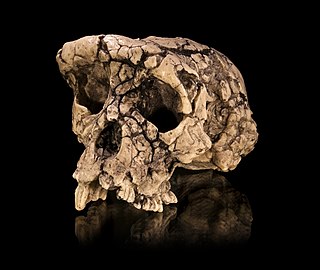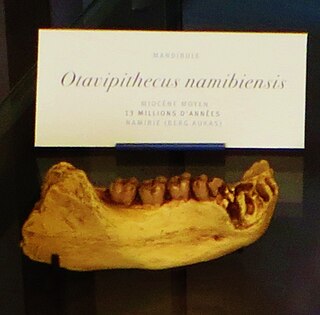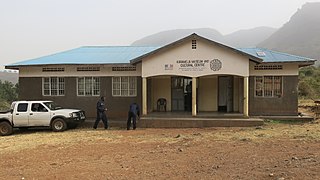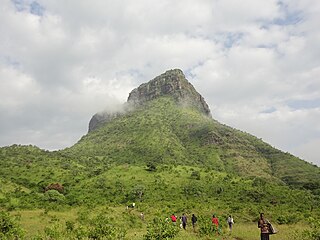
Orrorin is an extinct genus of primate within Homininae from the Miocene Lukeino Formation and Pliocene Mabaget Formation, both of Kenya.

Sahelanthropus tchadensis is an extinct species of the hominid dated to about 7 million years ago, during the Miocene epoch. The species, and its genus Sahelanthropus, was announced in 2002, based mainly on a partial cranium, nicknamed Toumaï, discovered in northern Chad.

Proconsul is an extinct genus of primates that existed from 21 to 17 million years ago during the Miocene epoch. Fossil remains are present in Eastern Africa including Kenya and Uganda. Four species have been classified to date: P. africanus, P. gitongai, P. major and P. meswae. The four species differ mainly in body size. Environmental reconstructions for the Early Miocene Proconsul sites are still tentative and range from forested environments to more open, arid grasslands.

The Tugen Hills are a series of hills in Baringo County, Kenya. They are located in the central-western portion of Kenya.

Martin Pickford is a lecturer in the Chair of Paleoanthropology and Prehistory at the Collège de France and honorary affiliate at the Département Histoire de la Terre in the Muséum national d'Histoire. In 2001, Martin Pickford together with Brigitte Senut and their team discovered Orrorin tugenensis, a hominid primate species dated between 5.8 and 6.2 million years ago and a potential ancestor of the genus Australopithecus.

Samburupithecus is an extinct primate that lived in Kenya during the middle to late Miocene. The one species in this genus, Samburupithecus kiptalami, is known only from a maxilla fragment dated to 9.5 million years ago discovered in 1982 and formally described by Ishida & Pickford 1997. The type specimen KNM-SH 8531 was discovered by the Joint Japan-Kenya Expedition at the SH22 fossil site in the Samburu District, a locality where several other researchers found no ape fossils.

Dendropithecus is an extinct genus of apes native to East Africa between 20 and 15 million years ago. Dendropithecus was originally suggested to be related to modern gibbons, based primarily on similarities in size, dentition, and skeletal adaptations. However, further studies have shown that Dendropithecus lacks derived hominoid traits. Instead, the traits shared between this taxon and modern primates are primitive for all catarrhines. Dendropithecus is now considered to be a stem catarrhine, too primitive to be closely related to any modern primates.

Morotopithecus is a genus of fossil ape discovered in Miocene-age deposits of Moroto, Uganda.

Metapterodon is an extinct genus of hyainailourid hyaenodonts of the subfamily Hyainailourinae, that lived in Africa during the early Oligocene to early Miocene. Fossils of Metapterodon were recovered from the Egypt, Uganda, Elisabeth Bay Formation in Namibia, and Rusinga Island and Karungu in Kenya.

Otavipithecus namibiensis is an extinct species of ape from the Miocene of Namibia. The fossils were discovered at the Berg Aukas mines in the foothills of the Otavi mountains, hence the generic name. The species was described in 1992 by Glenn Conroy and colleagues, and was at the time the only non-hominin fossil ape known from southern Africa. The scientists noted that the surrounding area of the discovered specimen included fauna dated at "about 13 ± 1 Myr". The fossils consist of part of the lower jawbone with molars, a partial frontal bone, a heavily damaged ulna, one vertebra and a partial finger bone.

Karamoja Regional Museum is a public museum in Moroto Town run under the Department of Museums and Monuments in the Ministry of Tourism, Wildlife and Antiquities of Uganda. It also serves as a cultural center where cultural heritage in form of objects is showcased for people to access and appreciate the cultural heritage of the Karamoja sub-region.
Micropithecus is an extinct genus of primates that lived in East Africa about 19 to 15 million years ago, during the early Miocene. The genus and its type species, Micropithecus clarki, were first scientifically described in 1978.

Nyanzapithecus pickfordi is an extinct species of primate from the Middle Miocene of Maboko Island, Nyanza Province, Kenya. It had an average body mass of around 10 kg (22 lb).

Brigitte Senut is a French paleoprimatologist and paleoanthropologist and a professor at the National Museum of Natural History, Paris. She is a specialist in the evolution of great apes and humans.
The Hiwegi Formation is a geological formation on Rusinga Island in Kenya preserving fossils dating to the Early Miocene period. The Hiwegi Formation is known for the well preserved plant fossils it preserves, which indicate a tropical forest environment that underwent wet and dry periods. The middle members of the formation in particular indicate a brief period in which conditions were notably dryer with a more open environment compared to older and younger units. Some of the formation's fauna, such as an early ancestor of the modern aye-aye and a chameleon of the genus Calumma, link Miocene East Africa to modern day Madagascar.
Asilifelis is an extinct genus of small felid that lived in what is now Kenya during the Early Miocene. Despite its fragmentary remains, it is remarkable because of its small size and advanced dentition. It contains a single species, Asilifelis cotae.

Mount Napak is an extinct volcano in the Napak District of Uganda. Located on the northern edge of the Bokora Game Reserve, it reaches an estimated height of 2103m above sea level. An alkaline volcano which erupted carbonatite-nephelinite material during the Early Miocene on the margin of the Great Rift Valley, subsequent erosion affords volcanologists an opportunity to inspect its once internal structures. Moreover, volcanic ash deposits and paleosols preserve a range of both animal and plant fossils, significantly including numerous primate taxa.
Diamantofelis is an extinct genus of felids that lived in what is now Namibia during the Early Miocene. It contains a single species, Diamantofelis ferox.
Namafelis is an extinct genus of felids that lived in what is now Namibia during the Early Miocene. It contains a single species, Namafelis minor. Closely related to Diamantofelis, it is of “Pseudaelurus-grade”, and therefore a rather basal member of the cat family.
The Lukeino Formation is a geologic formation located in Kenya and it dates to the Late Miocene (Messinian).














